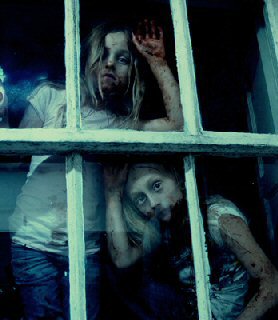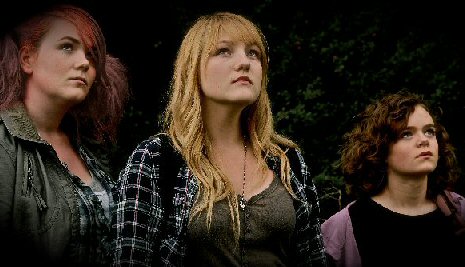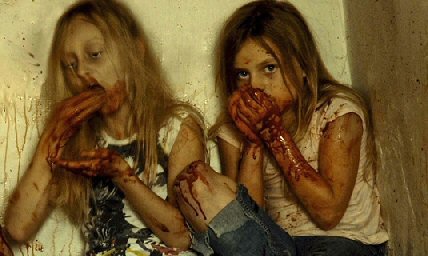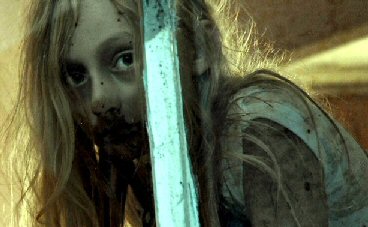Following the growing success of Post-Apocalyptic shocker CHILDREN OF A DARKER DAWN, Stu Willis caught up with writer/director Jason Figgis to discuss the film, his career and incoming plans in another exclusive SGM Spotlight interview…

Stu: Hi Jason, congratulations on your film, CHILDREN OF A DARKER DAWN. It's easily one of the most impressive horror features of the last decade for me. Can you give readers a little bit of your background? What prompted you to make films, and what led you to the place where you were in a position to make CHILDREN?
Jason: Thank you Stuart. Much appreciated. I started off in animation (working on ''Teenage Mutant Ninja Turtles’’ then for Steven Spielberg on ''American Tail 2: Fievel Goes West'' and for Richard Williams on ''The Thief and the Cobbler'') before moving to live action where I started out in 2002, directing and producing a feature-length film on the work of acclaimed photographer Sir Simon Marsden called ''The Twilight Hour''. This film played for three years on Discovery Civilisations and was distributed to 100 countries in 2004. I then directed several more documentaries for Sky One and Sky Arts before moving into narrative fiction. My first feature film in this area was an experimental noir feature called ''3Crosses'' (which is being released in the US and Canada in 2014 on DVD under the alternate title ''Once Upon a Time in Dublin'') and starred acclaimed actor Emmett J. Scanlan (Charlie Casanova). This film was pretty much a relentless battery of violence for its full 90-minute running length, and so, following this production, I realised that I wanted my films to follow a clearer path of narrative structure… which brings us to ''Children of a Darker Dawn''.
Stu: Post-Apocalyptic horror films are ten-a-penny these days. What provisions did you make going into CHILDREN to ensure your film would be different?
Jason: I was pretty much determined that I wanted to eschew the usual paths of constant threat and horror for a film that would be much more grounded in the reality of the boredom that would set in when all adults are gone; when kids realise that mundanity will become quite a salient factor in their day to day lives - unless they come together and form a workable society and try to build on the ashen landscape of a world without adults. In this story the rot is only just setting in with these survivors as only a few months have elapsed in the interim. Yes, teenagers arguing about pretty much nothing is mundane; it is boring at times, but I felt that if I was to remain as true as possible to what I felt would be a more realistic rendering of their lives, then these elements could not be glossed over.
Stu: So, "The Railway Children". A classic book for kids of a certain age. Can you elaborate on what the book means to you, and how it became integral to the film you were making?
Jason: This book has always been my favourite story; so much so that when I was a boy I used to write short stories in the Edwardian style. I decided very early on in the process of putting the screenplay together that I wanted a device to unify certain elements of the story for the sisters Evie (Catherine Wrigglesworth) and Fran (Emily Forster). I wanted a focus for them; a semi-salve against the horrors of their predicament and found that my own favourite childhood story could act as a very believable focus for them.

Stu: I suppose that leads neatly into me asking what your ultimate theme was with CHILDREN?
Jason: I really wanted to look at a situation whereby children; who universally rely on their parents (and adults in general) to guide them through the journey of childhood to adulthood are plunged into a horrific scenario where this constant, this security net - is pulled out from beneath them and they are left to make their own decisions - good or bad - and to deal with the consequences of these decisions amongst their peers. I wanted to pit innocence against a backdrop of a post-apocalyptic landscape and see how they would cope with what is thrown at them on a daily basis.
Stu: The settings are hauntingly quiet. Where did you shoot the film, and how'd you manage to get such a barren-looking landscape? Are those derelict houses purpose-built, for example, or did people vacate their homes for you?
Jason: I needed a backdrop that was believable and on a low budget that meant using the most barren landscapes possible. I wanted a sense of emptiness; a loneliness etched into the surroundings. I filmed in the Dublin mountains on roads that were rarely used. I even filmed in the shells of houses that were abandoned in Ireland's economic collapse and the main bulk of the film was shot in a protected structure; a mid-Victorian Convent - kindly donated for the two week shoot by a group of nuns who were recently housed in a newly built high-spec apartment block.
Stu: Obviously, I need to ask about your phenomenal cast. Please tell us more about these wonderful young people, in particular Wrigglesworth and Forster.
Jason: All of the children cast in the film were from the same performance arts school in Dublin (the Habemus Performing Arts School). I marched in one day and told the senior class that we would be shooting a feature film. None of them believed me but they all fell in with the idea and very enthusiastically helped me change the dialogue to suit their own way of speaking. I decided early on that I was going to write the characters based around the real personalities of the children cast in the film and this worked very well as they felt that they didn't have to ''act'' but more to ''re-act'' to those around them and the believable environment we wanted to immerse them in on the shoot itself. Catherine Wrigglesworth was very much one of the driving forces behind the film and she helped me marshall the other children during rehearsals and to keep them focussed and on track. I cast Emily Forster from the Intermediate class but she is a real live wire and needed some serious calming. The way I managed this was by bringing her into the senior class and making her sit with and bond with Catherine at all times and for Catherine to treat her as a ''real'' little sister. This worked brilliantly and they began to bond immediately. Many times I would turn around to see Catherine's arm draped about Emily's shoulder in class and Emily leaning against her chest, completely relaxed into the process of finding the character. They are both highly intelligent and sophisticated girls and this focus helped the rest of the teenage cast to find their best work in the characters that had been written for them. I was blown away by their universal dedication.

Stu: They did you proud! Were there any hurdles that you encountered as a result of directing such young actors? Not only in terms of any potential brattishness, but also in terms of the subject matter you were dealing with being quite harrowing.
Jason: Oddly enough, there were no problems at all with any member of the cast. They had a full year of rehearsals before we arrived on set so they were just about ready to burst with enthusiasm to realise this film. They were just genuinely excited and focussed on the work at hand. When it came to the horror; they revelled in it in the way that children always do… for them, the more blood and horror, the better.
Stu: Cool. I alluded to CHILDREN being a horror film in my second question. However, I did mention in my review that labelling the film as such seems to be doing a disservice to its many facets. How would you categorise your film?
Jason: I agree. I really look on the film as a drama, but set against a post-apocalyptic landscape (which automatically puts it in a genre category). I just wanted to explore what these children would see as their options in a radically altered world.
Stu: I'm not going to ask what your budget was, but what's evident here is that you don't need a shitload of cash to make an attractive, thought-provoking and well-played film. Having said that, there must've been days when working on a tight budget was difficult. What were the biggest obstacles, and how did you overcome them?
Jason: Yes, the film was shot on a shoe-string budget. We didn't have Full HD for this picture but instead filmed on the inferior HDV but I found the bleak grunginess of this medium served to add to the atmosphere of the world we were trying to put across in the film. I have to say that the entire shoot went without any real issues to hamper what we were trying to achieve. The kids were always on form and the locations pretty much fell in our laps.
Stu: Who's your favourite character in the film, and why?
Jason: Oddly enough, the character I identify with most when I was writing it (and how Ellen Mullen played it) is Cassandra. I feel she had the most to deal with when the outbreak occurred and is also a character who had some of the tougher decisions to make post-outbreak. I find it interesting how that shaped her as a young woman by the time she returned to the kid's commune.

Stu: What happens to those who survive DARKEST DAWN? Are they doomed to develop the same symptoms as their parents?
Jason: The idea is that the children will not develop symptoms of the illness when they reach maturity because the strain will have died out. Of course, that does not mean that an even more powerfully virulent strain won't develop later on...this is one of the reasons that I wouldn't be interested in tackling a part two. I kind of want to leave it open. That said, if a TV network wanted me to do a series of it; I would jump at the chance.
Stu: The film's been really well-received, everywhere it's played. What's your experience been of festival screenings, feedback etc?
Jason: I am thrilled how the film has been received. Those who like the film completely understand how I didn't try and ''glorify'' their predicament with flailing zombies and the threat of a new strain outbreak. These reviewers who have embraced the film have enjoyed the mundane nature of the children's day to day lives in the aftermath of such a devastating outbreak and pretty much share my belief that things would grind to a mind numbing halt - at least until some bright spark re-ignited the human instinct not just to survive but to once again, prosper.
Stu: What's next for you? Is a sequel to CHILDREN feasible, and if so which direction would you see that heading in?
Jason: I am now in post-production of a new horror feature film called ''The Ecstasy of Isabel Mann''. This is the story of troubled teenager Isabel Mann (Ellen Mullen - Children of a Darker Dawn) who is seduced into an incredibly violent sect of day-walking vampires. Her class mates start to go missing and two detectives; Witham (Neill Fleming - Game of Thrones, A Christmas Carol, Portrait of a Zombie) and Barrett (Matthew Toman - Don't You Recognise Me?) believe her to be the prime suspect. Nothing is quite as it seems for those about her as the disturbed teenager runs amok killing at will in the woodlands by her home; aided by her vampire guides Mirjana (Mirjana Rendulic - Amber) and Alejo (newcomer Karim Elgendy) who are training her in the art of the kill - with horrifically bloody results for those closest to her. This is a full HD feature and a much bigger budget than ''Children of a Darker Dawn''. This film sees the return of several CHILDREN cast members which include Ellen Mullen who played 'Cassandra', Adam Tyrrell who played 'Helman' and Emily Forster who played 'Fran'.
I will send you a preview copy if you would like to review it when it is completed this spring.
Stu: That would be excellent, thank you. And thanks again for your time - good luck with your film!
Jason: Thank you so much for your support. It means a huge amount.
Special thanks to Jason Figgis.